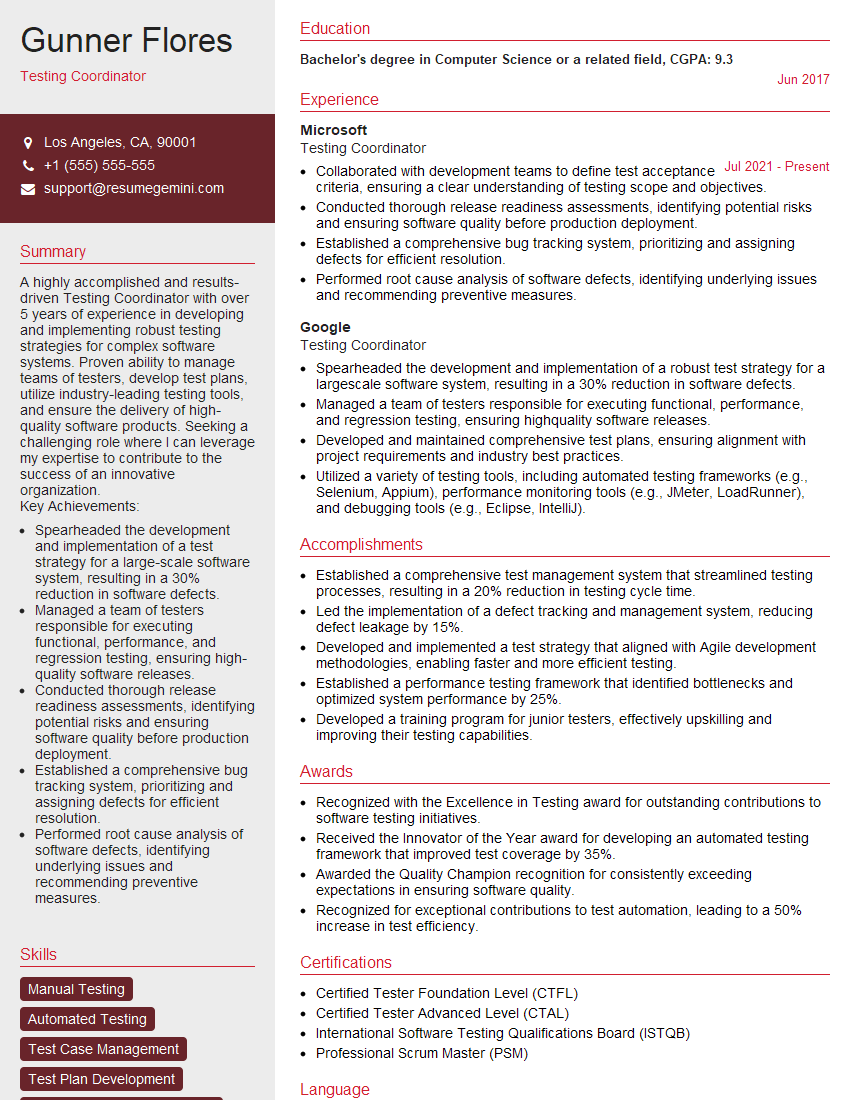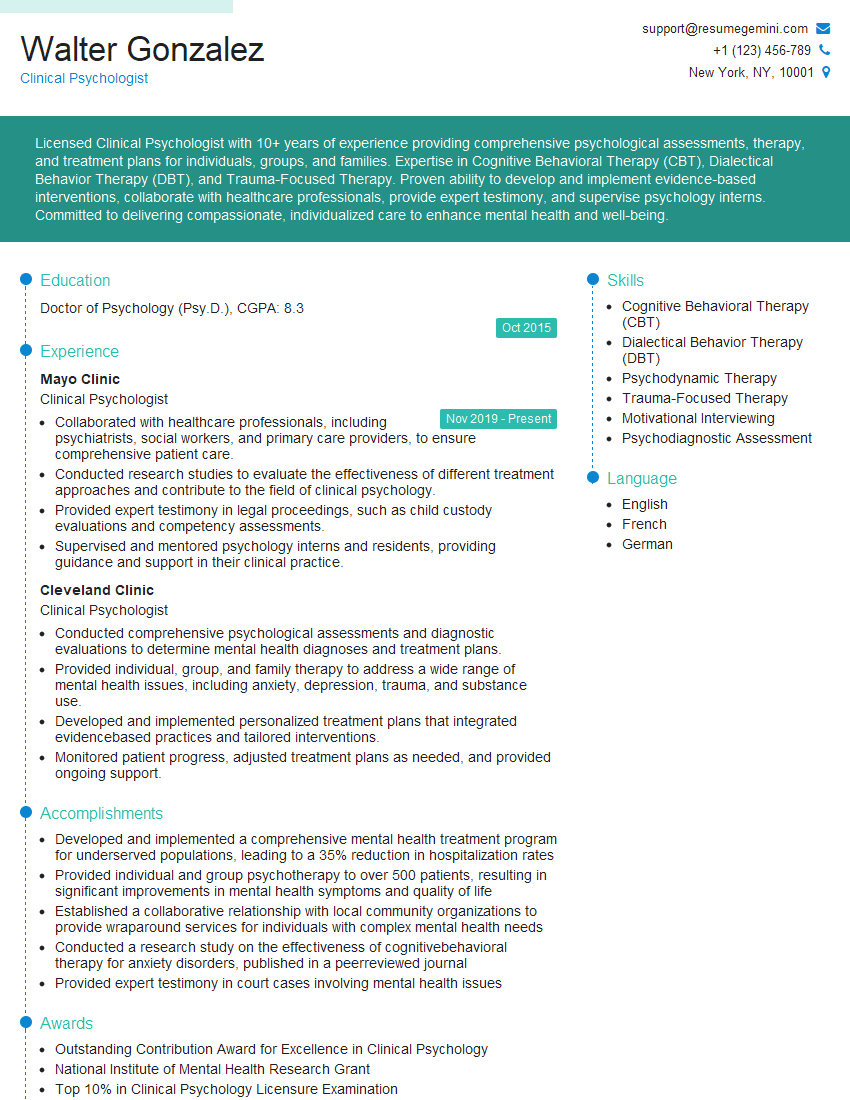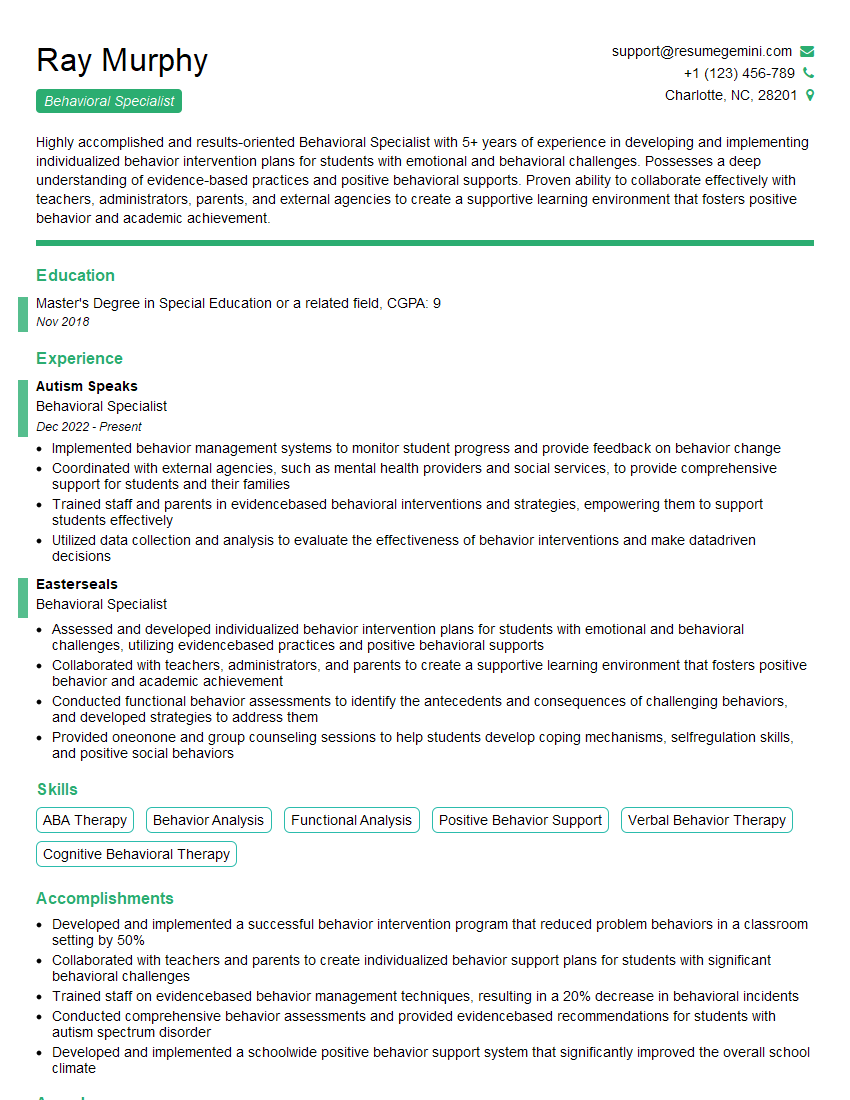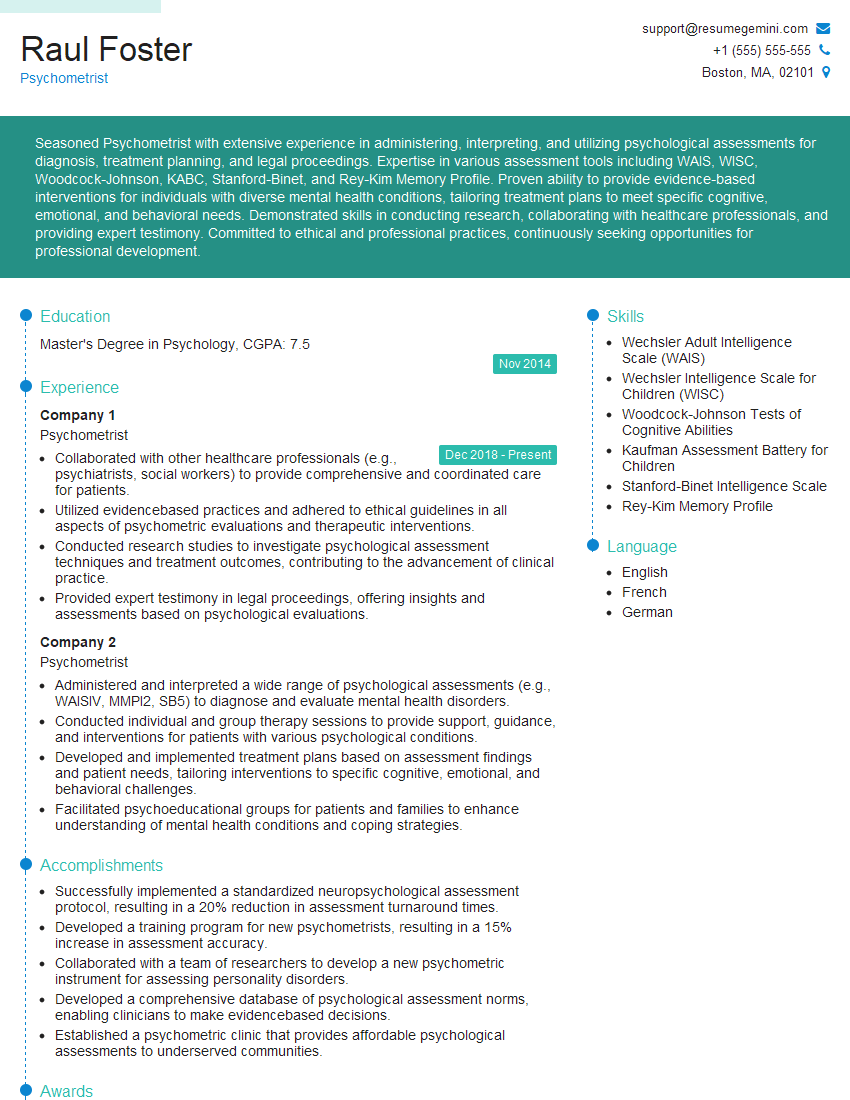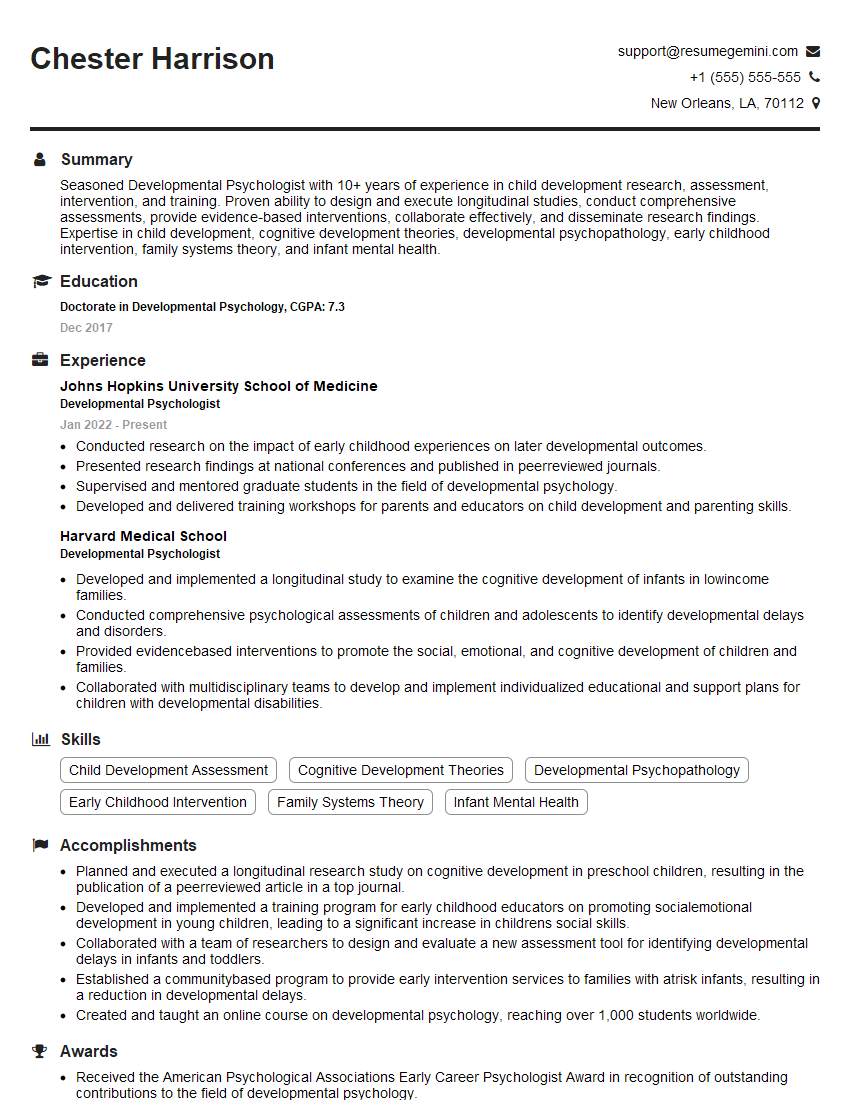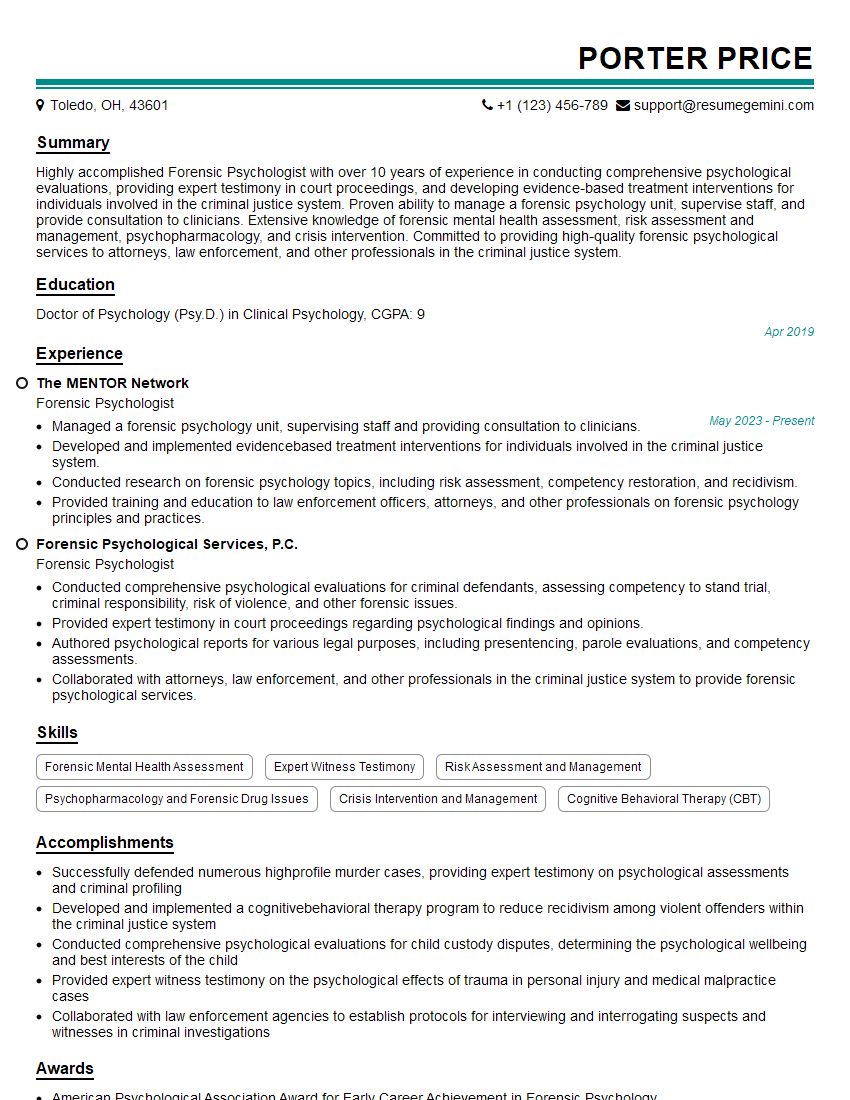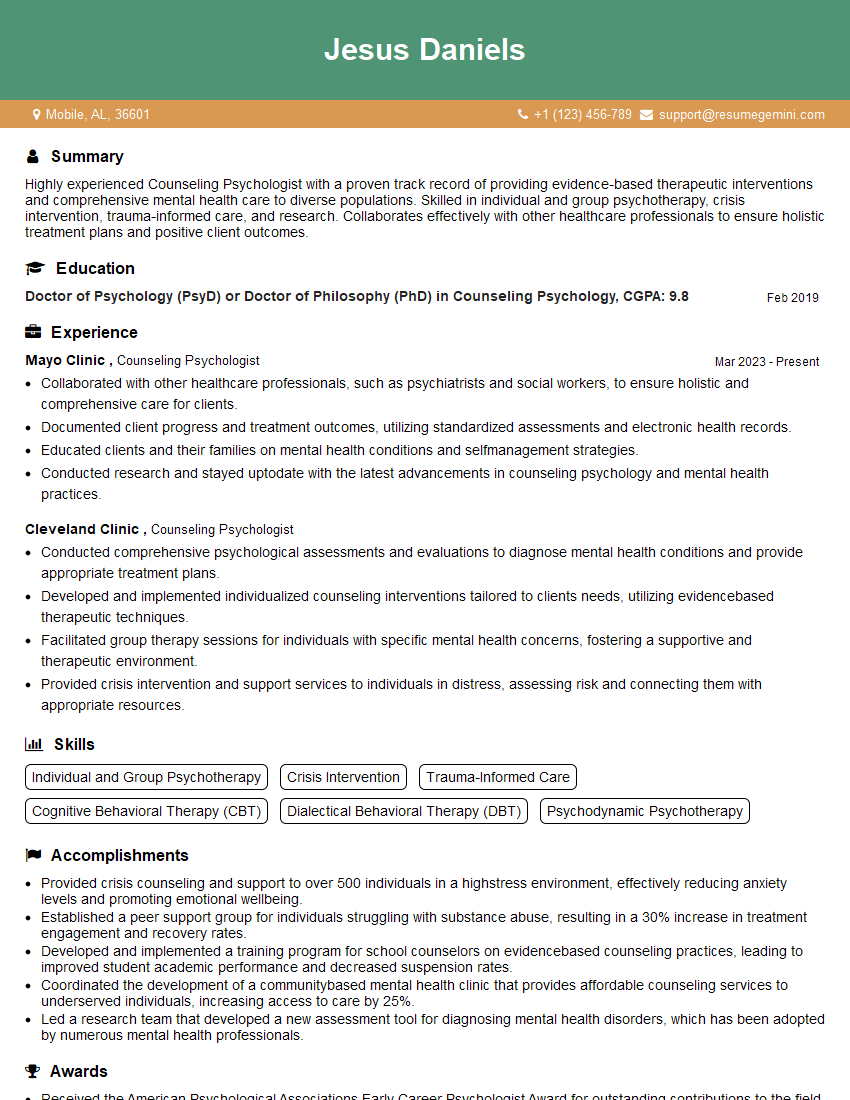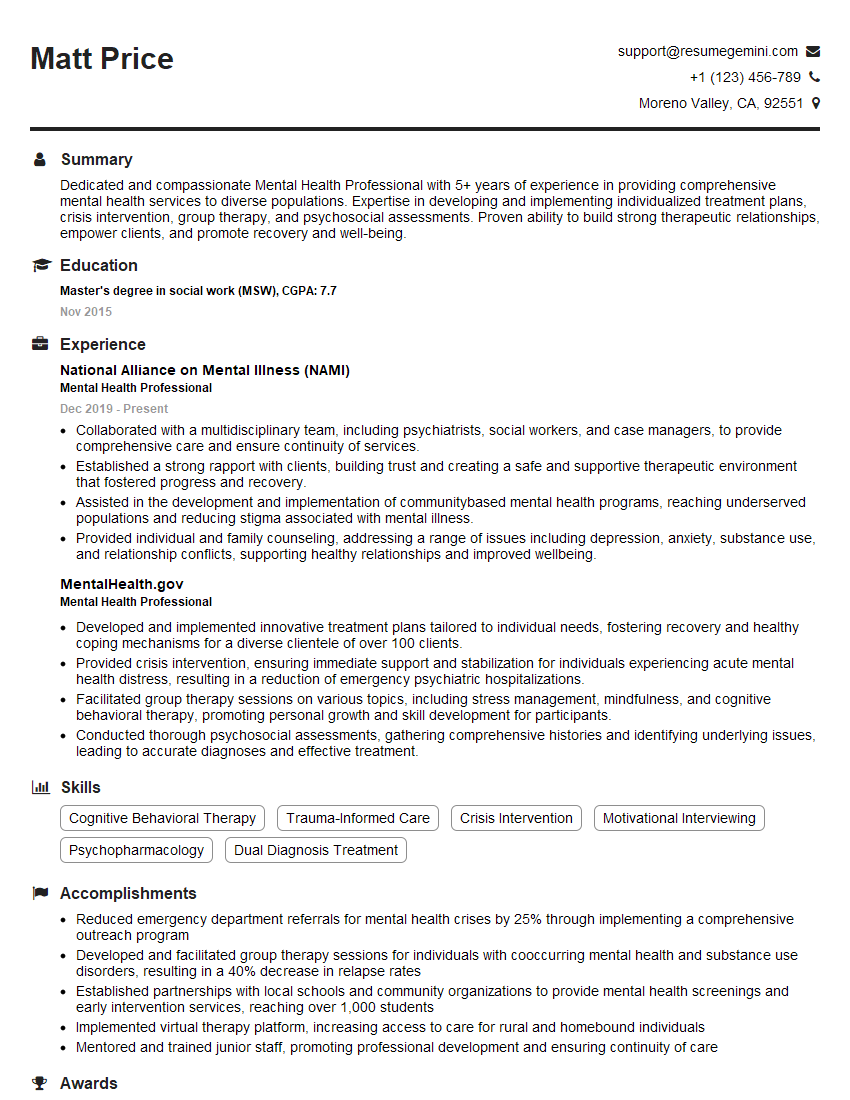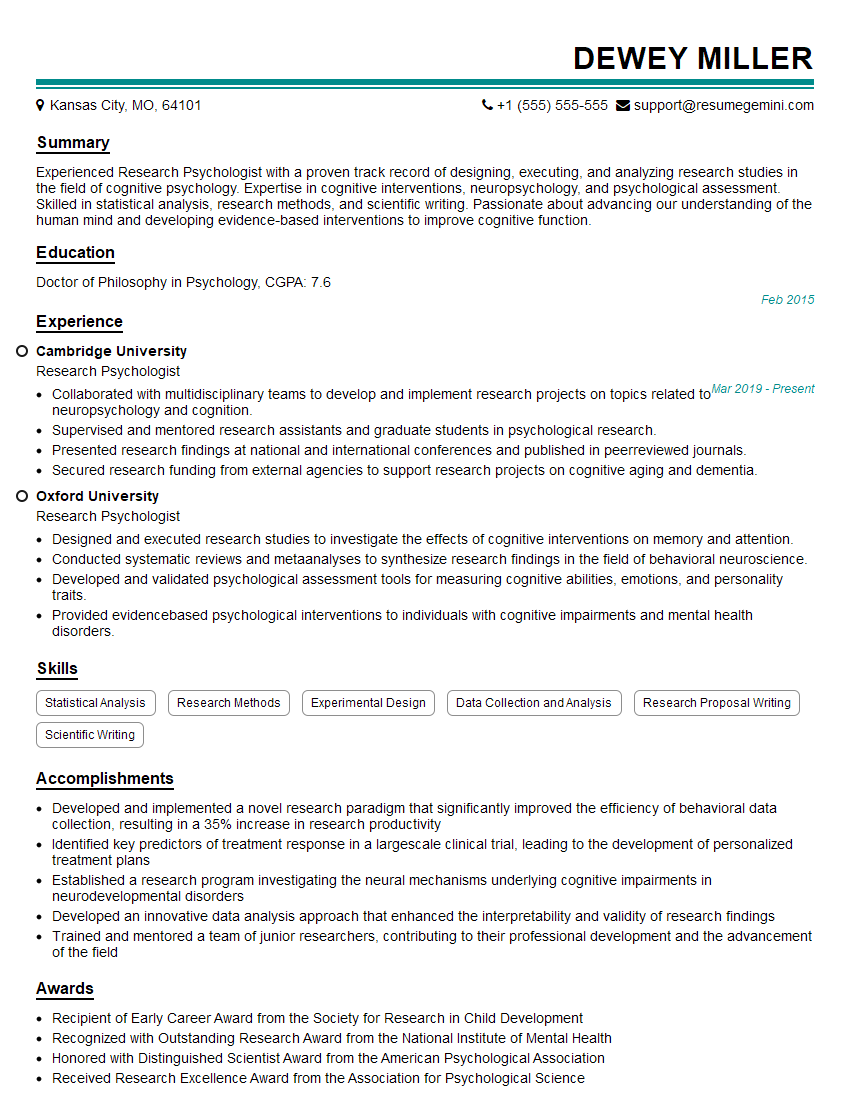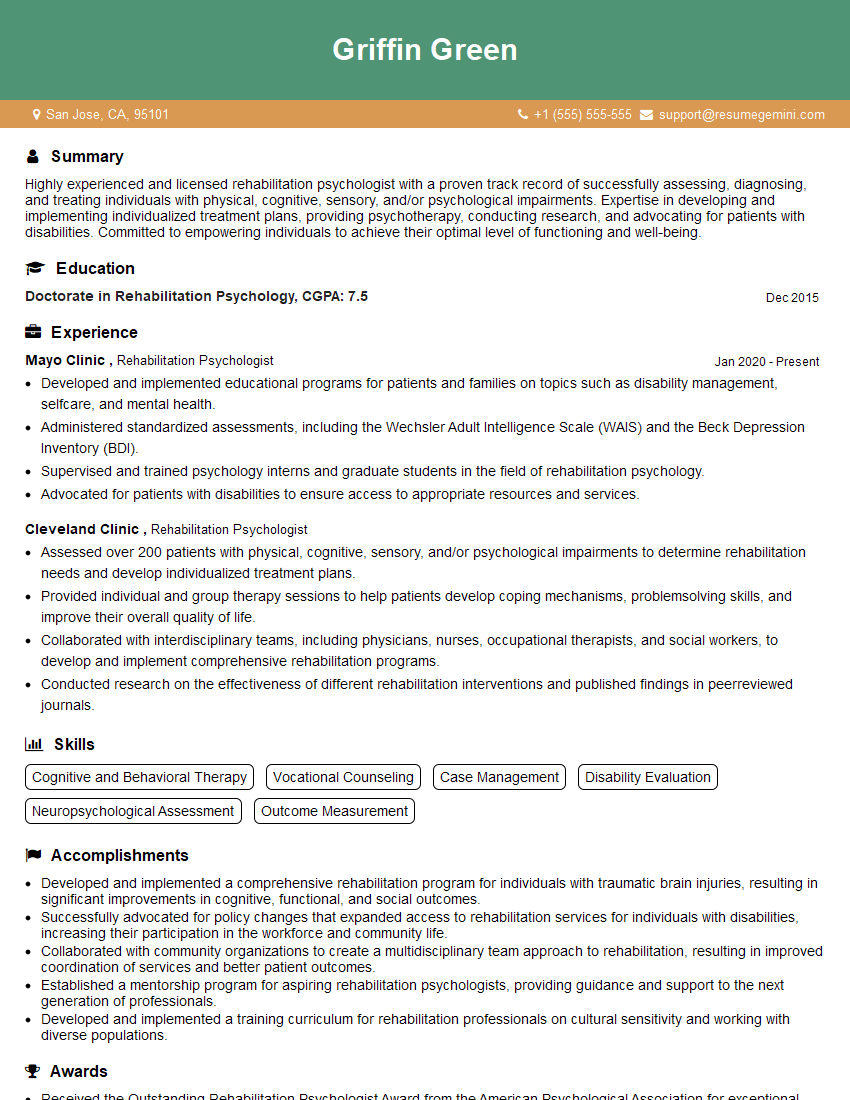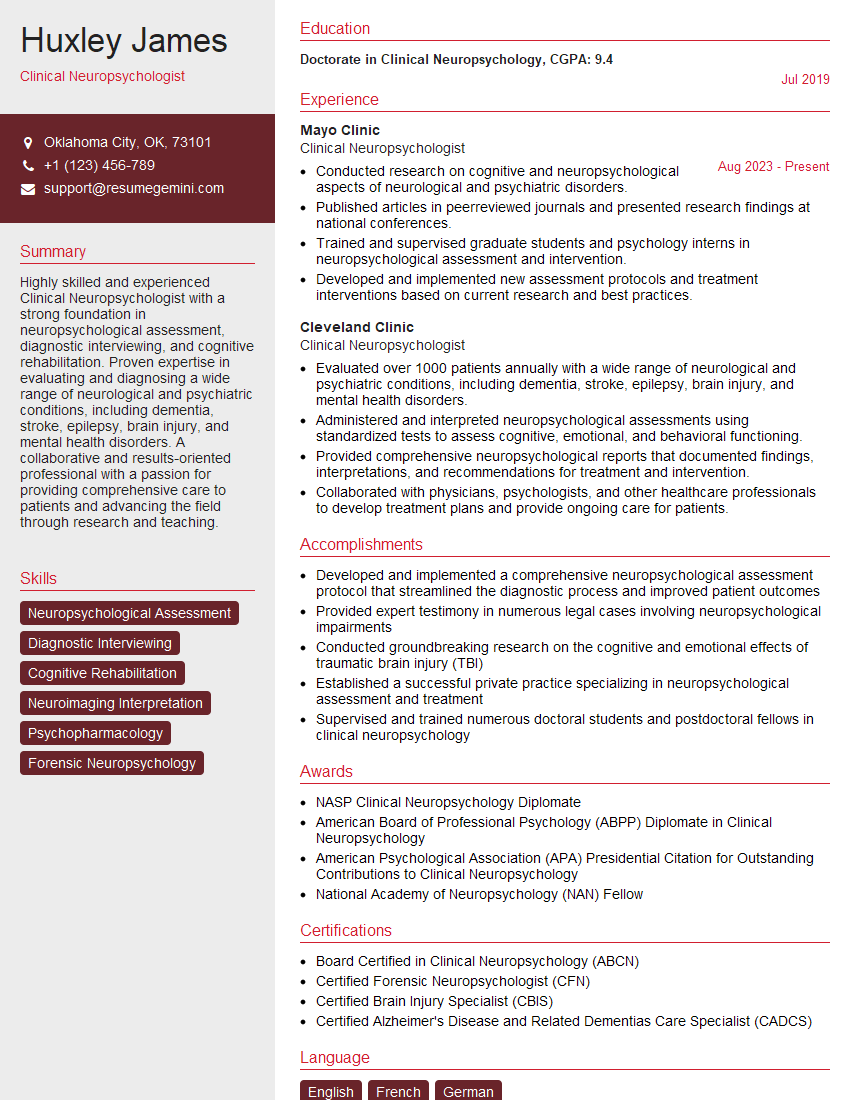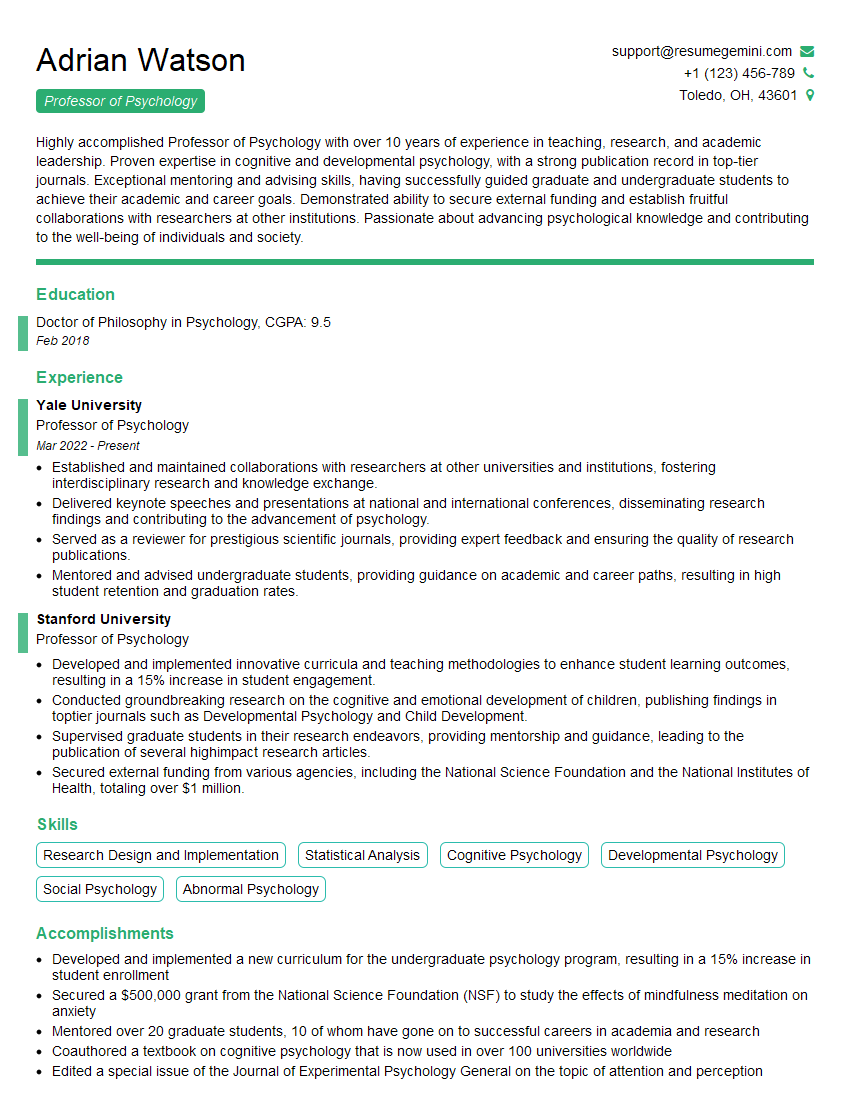Preparation is the key to success in any interview. In this post, we’ll explore crucial Psychodiagnostics interview questions and equip you with strategies to craft impactful answers. Whether you’re a beginner or a pro, these tips will elevate your preparation.
Questions Asked in Psychodiagnostics Interview
Q 1. Describe the process of selecting appropriate psychological tests for a specific client presentation.
Selecting the right psychological tests is crucial for accurate assessment. It’s akin to choosing the right tools for a specific job – a hammer won’t fix a leaky pipe. The process begins with a thorough clinical interview to understand the client’s presenting problem, history, and referral question. This helps identify the areas needing assessment, like cognitive functioning, personality traits, or specific symptoms. Then, I consider the client’s age, cultural background, and language proficiency to ensure test appropriateness and minimize bias. I also evaluate the test’s psychometric properties – reliability (consistency of results) and validity (measuring what it claims to measure) – to ensure accuracy. For example, if a client presents with symptoms suggestive of depression, I might select the Beck Depression Inventory (BDI-II) for a self-report measure of depressive symptoms and potentially the Minnesota Multiphasic Personality Inventory (MMPI-2-RF) for a broader personality assessment that includes depression scales. The selection is always individualized and justified based on the specific needs of each client.
- Step 1: Clinical Interview: Gather detailed information about the client’s concerns, history, and background.
- Step 2: Identify Assessment Areas: Pinpoint the specific psychological constructs to be assessed (e.g., intelligence, personality, anxiety).
- Step 3: Test Selection: Choose tests with proven reliability and validity, considering the client’s characteristics and the referral question.
- Step 4: Review Test Manuals: Familiarize yourself with the test’s administration, scoring, and interpretation guidelines.
- Step 5: Justification of Test Selection: Document the rationale for choosing specific tests in the client’s file.
Q 2. Explain the difference between objective and projective psychological tests and provide examples of each.
Objective and projective tests differ significantly in their approach and interpretation. Objective tests are structured, standardized measures with clear scoring criteria, minimizing subjective interpretation. They typically involve multiple-choice or true/false questions. Projective tests, on the other hand, are unstructured and present ambiguous stimuli (like inkblots or pictures) to elicit responses that reveal unconscious thoughts and feelings. Interpretation relies heavily on clinical judgment.
- Objective Tests: Examples include:
- The Minnesota Multiphasic Personality Inventory (MMPI-2-RF): Assesses personality traits and psychopathology.
- The Beck Depression Inventory (BDI-II): Measures the severity of depressive symptoms.
- The Wechsler Adult Intelligence Scale (WAIS-IV): Measures cognitive abilities in adults.
- Projective Tests: Examples include:
- The Rorschach Inkblot Test: Individuals interpret ambiguous inkblots, revealing underlying personality characteristics.
- The Thematic Apperception Test (TAT): Individuals create stories based on ambiguous pictures, revealing their needs and motivations.
Think of it like this: an objective test is like a multiple-choice exam – the answer is clear. A projective test is like a creative writing assignment – the interpretation is open to more subjective understanding.
Q 3. What are the ethical considerations in administering and interpreting psychological tests?
Ethical considerations are paramount in psychodiagnostics. We must prioritize client welfare and ensure responsible test use. Key ethical considerations include:
- Informed Consent: Clients must understand the purpose of the testing, what it entails, and how the results will be used before consenting. This includes explaining the limitations of the tests and the potential benefits and risks.
- Confidentiality: Test results are confidential and should only be shared with authorized individuals (e.g., referring physician, client with their consent). HIPAA and other relevant privacy regulations must be strictly adhered to.
- Competence: Psychologists should only administer and interpret tests they are qualified to use. This requires adequate training and experience with the specific test.
- Cultural Sensitivity: Test selection and interpretation must consider the client’s cultural background to avoid bias and ensure accurate assessment.
- Test Security: Maintaining the integrity of the test materials is essential to prevent compromising the validity of the results. This includes preventing unauthorized access to test materials and ensuring that test questions are not discussed publicly.
- Avoiding Misinterpretation: Test results should be interpreted cautiously and holistically, within the context of the client’s overall presentation and history. Over-reliance on any single test or interpretation should be avoided.
Q 4. How do you ensure test validity and reliability in your assessments?
Ensuring test validity and reliability is crucial for trustworthy assessments. Validity refers to whether the test measures what it intends to measure, while reliability refers to the consistency of the test’s results. Several strategies ensure both:
- Selecting Validated Tests: Using tests with established validity and reliability coefficients from previous research. Test manuals provide information on the test’s psychometric properties.
- Proper Administration: Following standardized procedures for administering and scoring the tests as outlined in the test manual is essential for minimizing error and ensuring reliability.
- Using Multiple Measures: Combining several assessment methods (e.g., tests, interviews, observations) improves the validity and reduces reliance on any single measure. This creates a more comprehensive picture of the client.
- Considering Contextual Factors: Interpreting results in the context of the client’s background, current life situation, and cultural factors is crucial for accurate interpretation and avoids misinterpretations based solely on test scores.
- Ongoing Professional Development: Keeping up to date with the latest research and best practices in psychological assessment enhances the ability to critically evaluate test results and maintain a high standard of care.
Q 5. Explain the concept of standardization in psychological testing.
Standardization in psychological testing is a critical process that ensures consistency and comparability of results across individuals and settings. It involves establishing:
- Standardized Administration Procedures: Consistent instructions, time limits, and materials are used to minimize variability in how the test is given.
- Standardized Scoring Procedures: Clear and objective rules for scoring the responses to ensure that different examiners score the same responses in the same way.
- Normative Data: A representative sample of the population is tested to provide a benchmark for comparing individual scores. This allows us to determine how an individual’s score compares to others of similar age, gender, and background.
Imagine a recipe: standardization is like following the recipe precisely – everyone using the same ingredients and methods gets the same result. Without standardization, results would be subjective and lack comparability.
Q 6. Discuss the limitations of using psychological tests in isolation for diagnosis.
Relying solely on psychological tests for diagnosis is a significant limitation. Tests provide valuable data, but they do not paint a complete picture. A comprehensive assessment needs to incorporate multiple sources of information:
- Limited Scope: Tests assess specific aspects of functioning; they don’t capture the richness of human experience or the interplay of various factors contributing to a client’s difficulties.
- Test Bias: Tests can be influenced by factors like cultural background, language proficiency, and education level, leading to inaccurate or biased results if not carefully considered.
- Response Bias: Clients’ responses can be affected by factors like defensiveness, social desirability, or malingering.
- Lack of Context: Test scores alone do not consider the client’s life circumstances, personal history, and current stressors, which significantly affect their mental health.
Think of it like a puzzle – tests provide a few pieces, but the complete picture requires other information, like the client’s story, their relationships, and their environment. A holistic assessment integrates all these elements for a complete understanding.
Q 7. How do you interpret test results in conjunction with clinical interview data?
Integrating test results with clinical interview data is vital for a comprehensive and accurate assessment. It’s not about simply adding the two together; it’s about creating a narrative that makes sense of the whole picture. The clinical interview provides rich qualitative data about the client’s subjective experience, while tests offer quantitative data that helps support or challenge the clinical impressions formed during the interview.
- Clarifying Discrepancies: The interview can help clarify discrepancies between test scores and the client’s self-report. For example, a client might score high on an anxiety test, but downplay their anxiety during the interview. The interview can help explore the reasons for this discrepancy.
- Contextualizing Results: The interview provides the context within which to interpret test scores. Scores can be understood more meaningfully when considered alongside the client’s history, life events, and current situation.
- Generating Hypotheses: Test results can generate hypotheses about possible diagnoses or areas for further exploration, which can then be investigated further in the interview.
- Developing Treatment Plans: The combined data from the interview and tests helps tailor a treatment plan that addresses the client’s specific needs and challenges.
The process resembles detective work, where the interview provides the clues, and the tests offer supporting evidence to form a compelling case – the diagnosis and the treatment plan.
Q 8. Describe your experience with administering and scoring the Wechsler Adult Intelligence Scale (WAIS).
My experience with the Wechsler Adult Intelligence Scale (WAIS) is extensive. I’m proficient in administering all subtests, ensuring standardized procedures are meticulously followed – from establishing rapport with the client to precisely timing responses and managing the testing environment to minimize distractions. Scoring involves accurately recording raw scores, converting them to scaled scores using the appropriate tables, and calculating composite scores like the Full Scale IQ (FSIQ), Verbal Comprehension Index (VCI), Perceptual Reasoning Index (PRI), Working Memory Index (WMI), and Processing Speed Index (PSI). I’m adept at identifying and addressing potential issues like unusual response patterns or inconsistencies that might necessitate further investigation. For example, a client showing unexpectedly low performance on one subtest despite strong performance on similar tasks would prompt a review of the testing conditions and a consideration of potential contributing factors, such as anxiety or a specific learning disability. I carefully analyze the entire profile, not just the FSIQ, to understand the individual’s cognitive strengths and weaknesses. This allows for a more nuanced interpretation tailored to the individual’s specific context.
Q 9. What are some common pitfalls to avoid during the administration of psychological tests?
Common pitfalls during psychological test administration can significantly impact the validity of results. These include:
- Insufficient rapport: A tense or uncomfortable testing environment can hinder a client’s performance. Building a trusting relationship is paramount.
- Improper test administration: Deviations from standardized procedures, such as incorrect instructions or failing to adequately monitor for cheating, invalidate the results.
- Bias and subjectivity: Test administrators must remain objective. Unconscious biases can influence scoring or interpretations. For instance, preconceived notions about the client could unintentionally lead to inaccurate scoring or misinterpretations of their responses.
- Environmental distractions: Noise, interruptions, or uncomfortable seating can negatively affect performance. The test environment should be quiet, private, and comfortable.
- Testing fatigue: Long or demanding tests can lead to decreased concentration and inaccurate results. Regular breaks are essential, especially for longer assessments.
- Ignoring client cues: Paying attention to nonverbal cues – like signs of distress or confusion – is vital. A client exhibiting significant distress might require a postponement or modification of the test administration.
Avoiding these pitfalls requires rigorous training, adherence to standardized protocols, and a commitment to maintaining objectivity throughout the entire process. Regular supervision and continuing education are essential for maintaining high standards.
Q 10. How do you handle situations where test results are inconsistent with clinical observations?
Inconsistencies between test results and clinical observations necessitate a thorough and systematic investigation. This isn’t necessarily an indication of flawed testing. It often signals the need for a deeper understanding of the client’s situation. My approach involves:
- Reviewing the testing process: I’d meticulously examine the administration and scoring to rule out any procedural errors.
- Considering contextual factors: I’d delve into the client’s background, history, and current circumstances. Stress, medication, or other relevant life events might explain discrepancies.
- Gathering additional data: This might involve further clinical interviews, collateral information from family or friends, or additional psychological testing to clarify specific areas of concern. For example, if a client scores high on intelligence tests but presents with significant difficulties in daily living, we’d need to explore factors like executive function deficits or emotional regulation challenges.
- Consulting with colleagues: Seeking a second opinion from experienced clinicians can provide valuable insights and help identify alternative explanations.
The goal is to develop a comprehensive understanding of the individual, recognizing that psychological testing is just one piece of the puzzle. A collaborative approach, incorporating multiple data points, is crucial for accurate assessment and treatment planning.
Q 11. Explain the process of providing feedback to clients regarding their test results.
Providing feedback on test results is a crucial aspect of the psychodiagnostic process. It requires sensitivity, clarity, and an ability to translate complex information into understandable terms. I begin by explaining the purpose of the testing and emphasizing the limitations of any single test. I then present the results in a clear, jargon-free manner, focusing on the client’s strengths and weaknesses, using visuals like graphs to aid understanding. I avoid overly technical language and focus on explaining the implications of the findings in relation to their daily life and goals. For instance, if a client’s test shows difficulties with attention, I would explain how that manifests and provide concrete examples of how it affects their daily life and suggest coping strategies. The discussion is collaborative; I encourage the client to ask questions and share their perspectives. The process concludes with jointly formulating a plan for addressing any identified concerns, emphasizing empowerment and collaboration.
Q 12. Describe different types of psychological test reporting styles and their appropriateness.
Psychological test reports vary in style, each suited for specific audiences and purposes. Common styles include:
- Comprehensive reports: These provide in-depth analysis, including background information, test procedures, raw data, and extensive interpretation suitable for clinical settings or research purposes.
- Summary reports: These offer concise summaries of key findings, suitable for quick consultations or referrals.
- Interpretive reports: These focus on explaining the meaning of the test results in a way that’s easily understood by clients and other professionals.
- Legal reports: These are specifically tailored for legal settings, emphasizing objectivity and meeting legal requirements.
The choice of reporting style is dictated by the context. For example, a comprehensive report might be necessary for complex cases, while a summary report is appropriate for routine evaluations. It’s vital to tailor the report to the audience, ensuring the information is both accurate and accessible.
Q 13. How do you maintain confidentiality and protect the privacy of test data?
Maintaining confidentiality and protecting the privacy of test data is paramount. My practice adheres strictly to ethical guidelines and relevant regulations, including HIPAA. This involves:
- Secure storage: Test data is stored in locked cabinets and/or encrypted electronic files accessible only to authorized personnel.
- Limited access: Only those directly involved in the client’s care have access to their data. Access requests are carefully scrutinized.
- Informed consent: Clients are fully informed about how their data will be used and protected before testing begins. They are given the right to access, amend, or withdraw their data.
- Data disposal: Once the data is no longer needed, it is securely destroyed according to established protocols.
- Compliance with regulations: I maintain up-to-date knowledge of all relevant laws and regulations, ensuring adherence to best practices.
Protecting client privacy is not just an ethical obligation; it’s essential for fostering trust and ensuring the integrity of the assessment process.
Q 14. Discuss the impact of cultural factors on psychological test interpretation.
Cultural factors significantly influence psychological test interpretation. Tests developed in one cultural context may not accurately reflect the experiences and perspectives of individuals from different cultures. This can lead to misinterpretations and inaccurate diagnoses. For example, a test measuring verbal fluency might disadvantage individuals from cultures where quieter communication styles are valued. Similarly, certain items on personality tests could be biased toward the norms of the dominant culture, potentially leading to an inaccurate portrayal of a person’s personality traits. To mitigate this, it’s crucial to:
- Consider cultural background: The client’s cultural background, language proficiency, and acculturation level must be taken into account during testing and interpretation.
- Use culturally appropriate tests: Where possible, select tests that have been validated for use with the specific cultural group.
- Be aware of potential biases: Critically evaluate test items for potential cultural biases and consider alternative explanations for test results.
- Employ culturally sensitive interviewing techniques: Conduct interviews that consider the client’s communication style and cultural norms.
Understanding and addressing cultural factors ensures that assessments are fair, equitable, and reflect the individual’s true abilities and characteristics.
Q 15. What are some common biases in psychological testing and how can they be mitigated?
Biases in psychological testing can significantly impact the accuracy of assessment results. These biases can stem from the test itself (test bias), the administrator (rater bias), or the individual being tested (response bias).
- Test Bias: This occurs when a test unfairly penalizes certain groups due to factors unrelated to the construct being measured. For example, a test with culturally specific vocabulary might disadvantage individuals from different cultural backgrounds. Mitigation involves ensuring diverse representation in test development and standardization samples, and using culturally sensitive materials.
- Rater Bias: This arises when the examiner’s expectations or personal beliefs influence their scoring or interpretation of responses. For instance, a clinician might unconsciously interpret ambiguous responses more negatively if they already suspect a particular diagnosis. Mitigation strategies include using standardized scoring procedures, blind scoring (where the examiner is unaware of the individual’s background), and employing multiple raters to compare results.
- Response Bias: This refers to systematic tendencies in how individuals respond to test items, regardless of the content. Examples include social desirability bias (wanting to present oneself in a positive light), acquiescence bias (agreeing with items regardless of content), and malingering (exaggerating symptoms). Mitigation involves using validity scales (e.g., the L scale on the MMPI), incorporating forced-choice items, and employing methods to detect inconsistent responding.
Addressing these biases is crucial for ensuring fair and accurate assessments. It requires careful test selection, rigorous training for administrators, and awareness of the potential influence of individual response styles.
Career Expert Tips:
- Ace those interviews! Prepare effectively by reviewing the Top 50 Most Common Interview Questions on ResumeGemini.
- Navigate your job search with confidence! Explore a wide range of Career Tips on ResumeGemini. Learn about common challenges and recommendations to overcome them.
- Craft the perfect resume! Master the Art of Resume Writing with ResumeGemini’s guide. Showcase your unique qualifications and achievements effectively.
- Don’t miss out on holiday savings! Build your dream resume with ResumeGemini’s ATS optimized templates.
Q 16. How familiar are you with the Minnesota Multiphasic Personality Inventory (MMPI)?
I am very familiar with the Minnesota Multiphasic Personality Inventory (MMPI), both the original MMPI-2 and the revised MMPI-2-RF. I have extensive experience administering, scoring, and interpreting this widely used objective personality inventory. The MMPI-2 and MMPI-2-RF provide valuable information about personality traits, psychopathology, and clinical scales to aid in diagnostic and treatment planning. I understand the nuances of its various clinical scales (e.g., Depression, Hysteria, Psychopathy), validity scales (e.g., L, F, K), and the importance of considering the individual’s profile within the context of their background and presenting concerns. I routinely integrate MMPI findings with other assessment data for a comprehensive understanding of the client.
Q 17. Describe your experience with neuropsychological assessments.
My experience with neuropsychological assessments spans various settings, including inpatient and outpatient facilities. I’m proficient in administering and interpreting a wide range of tests to evaluate cognitive functions, such as memory, attention, executive functions, and language abilities. This includes tests such as the Wechsler Adult Intelligence Scale (WAIS), Wechsler Memory Scale (WMS), Trail Making Test, and Boston Naming Test. I’ve worked with individuals across the age spectrum, from children with learning disabilities to adults experiencing cognitive decline due to various neurological conditions. A recent case involved a patient with a suspected traumatic brain injury; thorough neuropsychological assessment helped determine the extent of cognitive deficits and guide rehabilitation planning.
Q 18. How do you differentiate between symptoms of various psychological disorders using psychodiagnostic tools?
Differentiating between symptoms of various psychological disorders necessitates a comprehensive approach. Psychodiagnostic tools, such as structured clinical interviews (SCID), personality inventories (e.g., MMPI), and behavioral observations, are crucial. For example, differentiating between Major Depressive Disorder and Generalized Anxiety Disorder might involve assessing the duration and prominence of depressed mood versus anxiety symptoms. The SCID’s structured format helps systematically explore diagnostic criteria. The MMPI can help identify underlying personality characteristics that might contribute to or exacerbate symptoms. Behavioral observations during the interview can provide further insights into the individual’s affect, demeanor, and cognitive functioning.
It is crucial to remember that symptom overlap exists across disorders, hence careful clinical judgment and integration of multiple data sources are essential. For instance, both depression and anxiety can manifest with fatigue, sleep disturbances, and irritability. A thorough assessment differentiates by considering the predominant symptom cluster, duration, timing, and contextual factors.
Q 19. Explain your understanding of differential diagnosis using psychological assessments.
Differential diagnosis in psychology involves systematically comparing and contrasting various potential diagnoses based on the client’s symptoms, history, and assessment findings. This process relies heavily on utilizing psychological assessments to gather data and rule out competing diagnoses. For example, a client presenting with anxiety symptoms could potentially have Generalized Anxiety Disorder, Panic Disorder, or even symptoms related to an underlying medical condition. Psychological assessments, such as anxiety-specific questionnaires and structured interviews, help systematically explore each diagnostic possibility, comparing symptom presentation to DSM-5 criteria. A thorough assessment ensures accurate diagnosis and subsequent targeted treatment planning.
Q 20. Describe your experience with interpreting projective tests like the Rorschach or TAT.
My experience with projective tests includes administering, scoring, and interpreting both the Rorschach Inkblot Test and the Thematic Apperception Test (TAT). I utilize comprehensive scoring systems for both (e.g., Exner’s Comprehensive System for the Rorschach). My interpretations emphasize a holistic approach, integrating qualitative and quantitative data to understand the individual’s underlying psychological processes, including their coping mechanisms, interpersonal relationships, and emotional regulation. I understand the limitations of projective tests and always consider them alongside other assessment data to avoid over-reliance on a single measure.
For instance, in a recent case using the TAT, a client’s recurring themes of abandonment and isolation in their narratives provided significant insight into their attachment style and potential for relational difficulties, which was corroborated by information obtained in clinical interviews and other assessments.
Q 21. Discuss the limitations and strengths of using projective testing in clinical practice.
Projective tests, while offering rich qualitative data and insights into the individual’s unconscious processes, also possess significant limitations. Strengths include their ability to tap into aspects of personality and emotional functioning that might not be readily accessible through self-report measures. They can be particularly useful in exploring implicit biases and underlying defense mechanisms.
- Strengths: Access to unconscious material, potential for uncovering unique and nuanced aspects of personality, exploration of interpersonal dynamics.
- Limitations: Subjectivity in interpretation, lack of standardized scoring and interpretation across clinicians, potential for low reliability and validity compared to objective measures, reliance on the client’s ability to understand and engage with the ambiguous stimuli.
Therefore, their use in clinical practice needs to be judicious. They should be employed as part of a comprehensive assessment battery, not in isolation. Integrating projective test results with information from structured interviews, objective personality measures, and behavioral observations enhances clinical judgment and minimizes the risk of misinterpretations. Clinicians should be extensively trained in administering and interpreting these tests to minimize subjectivity and ensure responsible usage.
Q 22. How do you manage a situation where a client refuses to complete a particular test?
A client’s refusal to complete a test is a common challenge. My approach prioritizes understanding the reason behind the refusal. It’s crucial to remember that assessment is a collaborative process, not a coercive one. I begin by creating a safe and empathetic space, actively listening to the client’s concerns. Perhaps they feel overwhelmed, anxious about the implications of the results, or mistrustful of the process.
- Exploring the Resistance: I’d ask open-ended questions like, “I understand you’re hesitant about completing this test. Can you tell me more about what’s making you feel this way?”
- Addressing Concerns: Once I understand the reason, I address their concerns directly and honestly, explaining the purpose of the test in a clear and non-judgmental way. If their concerns are valid (e.g., time constraints), I’d explore alternative assessment methods.
- Offering Alternatives: Depending on the situation, I might suggest a different test, a shorter version of the test, or a more qualitative approach, like a structured interview. The goal is to gather the necessary information while respecting the client’s boundaries.
- Documenting the Refusal: I carefully document the client’s refusal, including the reasons provided and the steps taken to address their concerns. This is crucial for maintaining ethical and professional standards.
For example, if a client refuses a lengthy personality inventory due to time constraints, I might offer a shorter, comparable measure or incorporate their verbal responses into a clinical interview to gain similar insights.
Q 23. What is your approach to integrating findings from different assessment methods?
Integrating findings from different assessment methods is essential for a comprehensive understanding of the client. It’s not about simply adding up scores, but rather synthesizing the information to build a coherent and nuanced picture. I utilize a process that involves several steps:
- Qualitative Integration: I look for patterns and themes across different measures. For example, if a projective test suggests underlying anxiety and a self-report inventory confirms this, it strengthens the overall assessment.
- Quantitative Comparison: Where applicable, I compare quantitative data from different tests. However, I’m mindful of the limitations of comparing scores across different scales and instruments.
- Considering Context: I always consider the client’s background, developmental history, and current life circumstances in interpreting the results. Test scores are only part of the story.
- Triangulation: This is a key component – using multiple methods to gather data on the same construct, enhancing the validity and reliability of conclusions.
- Clinical Judgment: Ultimately, clinical judgment plays a crucial role in integrating the findings. My experience and knowledge allow me to interpret the data in a holistic way and arrive at a clinically relevant diagnosis and treatment plan.
For instance, a client might score high on depression on a self-report measure, but their behavior in a clinical interview doesn’t fully align with that score. Integrating both data points allows for a more accurate interpretation, potentially revealing other factors at play.
Q 24. Explain the concept of test-retest reliability and its importance.
Test-retest reliability refers to the consistency of a test over time. A test with high test-retest reliability will produce similar results when administered to the same person under similar conditions on different occasions. It’s a critical aspect of psychometric properties, indicating the stability of the construct being measured.
Importance: High test-retest reliability is essential because it ensures that the test is measuring a stable trait or characteristic and not something that fluctuates significantly over short periods. This is particularly crucial when monitoring changes over time, such as in treatment progress or evaluating the impact of an intervention. A low test-retest reliability might suggest that the test is susceptible to factors unrelated to the construct being measured (e.g., mood fluctuations, situational factors). For example, a highly reliable depression scale should yield similar scores if administered a week apart, unless the individual’s depressive state has changed substantially.
Q 25. Discuss the role of psychodiagnostics in forensic settings.
Psychodiagnostics plays a vital role in forensic settings, providing objective and scientific evidence for legal proceedings. This involves assessment of various psychological constructs relevant to legal matters, including:
- Competency to Stand Trial: Assessing a defendant’s ability to understand the charges against them and participate in their own defense.
- Criminal Responsibility: Evaluating a defendant’s mental state at the time of the alleged offense to determine whether they can be held criminally responsible.
- Risk Assessment: Assessing the likelihood of future violence or other harmful behaviors.
- Child Custody Evaluations: Assessing the parenting capabilities of individuals involved in custody disputes.
- Personal Injury Claims: Evaluating the extent of psychological damage resulting from an accident or other traumatic event.
In forensic settings, the psychodiagnostic process needs to be rigorous and meticulously documented, with a strong emphasis on objectivity and adherence to ethical guidelines. The reports generated are often subject to intense scrutiny in legal proceedings, requiring clear, concise, and defensible conclusions.
Q 26. How do you ensure the ongoing professional development of your psychodiagnostic skills?
Ensuring ongoing professional development is paramount in the ever-evolving field of psychodiagnostics. My approach includes a multi-faceted strategy:
- Continuing Education: I regularly participate in workshops, conferences, and seminars related to new assessment techniques, psychometrics, and relevant legal updates.
- Supervision: I engage in regular supervision with experienced colleagues to discuss challenging cases, refine my assessment skills, and ensure ethical practice.
- Reading and Research: I stay updated on the latest research findings, reviewing peer-reviewed journals and books to enhance my knowledge of assessment tools and interpretation techniques.
- Networking: I participate in professional organizations and networks, engaging with other professionals to share insights and learn from their experiences.
- Self-Reflection: I regularly reflect on my practice, identifying areas for improvement and seeking feedback from supervisors and colleagues.
For example, I recently completed a training program on the use of a new neuropsychological assessment tool. This continuous learning ensures I can provide the most up-to-date and effective psychodiagnostic services to my clients.
Q 27. Describe a challenging case involving psychodiagnostic assessment and how you approached it.
One particularly challenging case involved a young adult presenting with significant emotional dysregulation and self-harming behaviors. Initial self-report measures suggested borderline personality disorder, but the client’s presentation was inconsistent. They displayed periods of intense anger followed by deep depression, making it difficult to establish a clear diagnosis.
My Approach: I integrated multiple assessment methods. I utilized structured clinical interviews to explore the history of trauma and interpersonal relationships, supplemented by projective tests to understand the underlying unconscious conflicts. I also conducted neuropsychological testing to rule out any neurological contributions to their emotional dysregulation. Through this multi-modal approach, I found that while some symptoms aligned with borderline personality disorder, the core issue was unresolved childhood trauma leading to complex PTSD. This case highlighted the importance of going beyond initial diagnostic impressions and considering the complex interplay of factors contributing to a client’s presentation.
Q 28. What software or technology are you proficient in using for psychodiagnostic assessment?
I am proficient in using several software applications for psychodiagnostic assessment. This includes:
- Test administration platforms: Software that allows for the secure and efficient administration of various psychological tests, often with automated scoring and report generation.
- Statistical software packages: Programs such as SPSS or R for conducting statistical analyses on test data, calculating reliability coefficients, and performing other psychometric analyses.
- Electronic health record (EHR) systems: I use EHRs to securely store and manage client data, maintain comprehensive records, and ensure compliance with data privacy regulations.
- Specialized assessment platforms: Some platforms offer specific tools for scoring and interpreting certain tests or providing normative data.
Proficiency in these technologies allows for efficient data management, accurate scoring, and the generation of comprehensive reports. It also ensures that I can adhere to current best practices in ethical and professional standards.
Key Topics to Learn for Psychodiagnostics Interview
- Assessment Techniques: Understand the theoretical underpinnings and practical applications of various assessment methods, including projective tests (e.g., Rorschach, TAT), objective personality inventories (e.g., MMPI, NEO-PI-R), and cognitive assessments (e.g., Wechsler scales).
- Psychopathology: Demonstrate a strong grasp of diagnostic criteria for major mental disorders according to DSM-5 or ICD-11. Practice applying these criteria to hypothetical case studies.
- Ethical and Legal Considerations: Be prepared to discuss ethical dilemmas related to confidentiality, informed consent, and cultural sensitivity in assessment and reporting. Understand legal implications of psychodiagnostic work.
- Report Writing: Showcase your ability to write clear, concise, and comprehensive psychodiagnostic reports that effectively communicate findings to relevant audiences (e.g., clinicians, legal professionals).
- Test Interpretation and Validity: Discuss the limitations and strengths of different assessment tools. Understand concepts like reliability, validity, and standardization. Be prepared to analyze test data and draw appropriate inferences.
- Differential Diagnosis: Demonstrate your ability to distinguish between different mental disorders with overlapping symptoms, and justify your diagnostic choices based on clinical data.
- Cultural Competence: Discuss the importance of considering cultural factors when conducting psychodiagnostic assessments and interpreting results. Understand how cultural biases can influence assessment outcomes.
- Integration of Data: Explain how to integrate information from multiple sources (e.g., interviews, observations, collateral information) to form a comprehensive understanding of the individual’s functioning.
Next Steps
Mastering psychodiagnostics is crucial for a successful and fulfilling career in mental health. A strong understanding of assessment techniques and ethical considerations will significantly enhance your professional capabilities and open doors to a wide range of opportunities. To maximize your job prospects, it’s essential to create an ATS-friendly resume that highlights your skills and experience effectively. ResumeGemini is a trusted resource that can help you build a compelling resume tailored to the specific requirements of psychodiagnostic positions. Examples of resumes tailored to Psychodiagnostics are available to help you get started.
Explore more articles
Users Rating of Our Blogs
Share Your Experience
We value your feedback! Please rate our content and share your thoughts (optional).
What Readers Say About Our Blog
This was kind of a unique content I found around the specialized skills. Very helpful questions and good detailed answers.
Very Helpful blog, thank you Interviewgemini team.
